June 1996
Roger N. Shepard was always a prankster. As a boy, he delighted in playing visual tricks -- like the time he surreptitiously moved all the furniture out of his sister's room.
He went on to a distinguished career at Bell Labs, Harvard, and Stanford, all the while continuing to play visual tricks on people. By recording and analyzing their reactions, he discovered astonishing truths about mental processes. Shepard showed, for example, that when people compare two objects rotated at different angles, they first reorient the objects in their mind's eye. The astonishing part: Everyone does this at approximately 60° per second.
In the 1950s, Shepard began to discover universal laws that govern how people and animals perceive similarities among sensory input like colors, sounds, or smells. He worked out a computer method for measuring the perceived difference between stimuli.
When Shepard applied this method to colors, the computer yielded a circle. The physical wavelengths of visible light fall along a straight line, moving from red to violet; but the circle more accurately depicts the psychological (as opposed to physical) truth. This is that people perceive red and violet as more similar to each other than either color is to an intermediate color such as green. Shepard also discovered that:
- The distance between stimuli decreases along a particular curve -- a steep drop, followed by a slow tailing off (in mathematical terms, an exponential decay curve).
- All stimuli -- simple or complex -- produce the same curve.
- So do all experimental subjects -- whether humans, monkeys, rats, or pigeons.
Until Shepard began publishing his imagery work in the 1970s, no one had objectively measured mental imagery. It was thought to be impossible. The scientific community has since taken notice.
Today, his work influences fields as diverse as psychology, philosophy, computer science, linguistics, and neuroscience. Shepard says his image orientation work has been used in a pilot aptitude test. The test accurately identifies trainees who are most likely to make pilot errors. His imaging methods were also used in the design of a computer-based diagnostic system for breast and prostate cancers. Joseph L. Young, the NSF program director who has overseen Shepard's NSF grants for more than 19 years, anticipates other practical benefits such as better organization of control rooms and cockpit displays, as well as more effective educational programs.
In 1995, Shepard was awarded the National Medal of Science. He is noteworthy for other reasons as well. In an era of specialization, Roger Shepard is not only a scientist; he is a skilled artist and writer whose publications, while challenging, have broad appeal.
Shown here are a few drawings from his bookMind Sights,subtitledOriginal Visual Illusions, Ambiguities, and Other Anomalies With a Commentary on the Play of Mind in Perception and Art(W.H. Freeman and Co., 1990). In it, Shepard explains:
"The drawings ... achieve their effects by means of various visual tricks. But to call them tricks is not to imply that they are without psychological significance. The tricks work by taking advantage of fundamental perceptual principles that have been shaped by natural selection in a three-dimensional world. Our ability to make pictures, which emerged only recently on an evolutionary time scale, enables us to present the eyes with visual patterns that systematically depart from the patterns that we and our ancestors experienced in nature. In considering the ways pictures can trick the eye, we can gain insight into the nature and ultimate source of the principles of visual perception."
"OUR PERCEEPTUAL MACHINERY...IS DEEPLY ENTRENCHED"--ROGER N. SHEPARD
"Our perceptual machinery for making use of retinally available information about the disposition of objects in three-dimensional space is deeply entrenched in our nervous system and wholly automatic in its operation. Without our bidding or even our awareness of its existence, this machinery immediately goes to work on any visual input, including the visual input provided by a two-dimensional drawing. As a result, we cannot choose to see a drawing merely as what it is -- a pattern of lines on a flat, two-dimensional surface. To the extent that the pattern of lines conforms with the rules of linear perspective, for example, that pattern automatically triggers the circuits in the brain that make the three-dimensional interpretation appropriate to such a perspective display. Any consciously adopted intentions to ignore such an interpretation are largely powerless against the swift deliverances of this underlying machinery. This should not surprise us. We have inherited this machinery from individuals who, long before the advent of picturemaking, interpreted -- by virtue of this machinery -- what was going on in the three-dimensional world around them with sufficient efficiency to survive and to continue our ancestral line."
GRAVITATIONAL BENDING
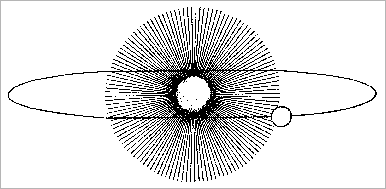 | FromMind Sights, by Shepard. |
"Of...psychological interest are illusions that are not already objectively present in the physical pattern of light reaching our eyes but that arise only in the psychological process of interpreting that pattern of light....[T]he two portions of the apparently elliptical (or even circular) orbit that overlap the lines radiating from the central sun are curved only in the eye of the beholder. Objectively, these two horizontal portions of the 'orbit' are perfectly straight, as can be verified by means of a ruler."
TERROR SUBTERRA
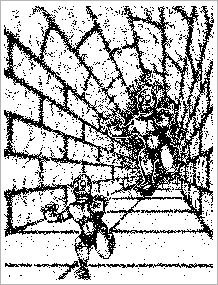 | FromMind Sights, by Shepard. |
"[T]he linear perspective of the subterranean tunnel (along with other depth cues, such as the relative heights of the projections of the two monsters on our retinas) supports the automatic perceptual inference that one of the two monsters is farther back in depth. The two monsters, nevertheless being exactly the same size in the drawing, subtend the same visual angle at the eye. The visual system therefore makes the additional inference that in order to subtend the same visual angle, the monster that is farther back in depth must also be larger."
"In addition to seeing them as different in size, do we also interpret their identical faces as expressing the different emotions -- such as rage on the part of the pursuer and fear on the part of the pursued?"
TURNING THE TABLES
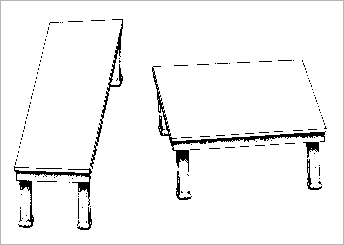 | FromMind Sights, by Shepard. |
"We remain oblivious to the anomalous character of many illusions until our visual experience is tested against some other, more objective evidence, such as that provided by measurement or tracing. There is nothing obviously amiss in Turning the Tables until one is told that the two seemingly differently shaped table tops are in fact identical in the picture plane. Clearly, this illusion arises because our visual system has once again given us depth interpretations of the two-dimensional drawing."
ARCH REMARK
 | FromMind Sights, by Shepard. |
"The actual three-dimensional structure of this arch might be strangely twisted, or simply tipped back -- so that the right-hand pedestal of the arch is suspended in the air (above the shadow indicated in the foreground). The apparently perfect alignment of this right-hand pedestal with the rectangular base in the background would then depend on the unlikely circumstance that we are viewing the scene from a very special vantage point."
L'EGS-ISTENTIAL QUANDRY
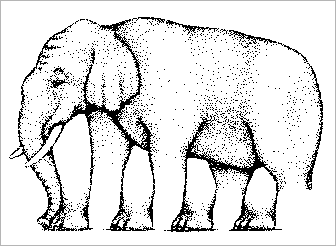 | FromMind Sights, by Shepard. |
"The elephant ... belongs to a class of objects that are truly impossible in that the object itself cannot be globally segregated from the nonobject or background."
TELEPHONE CONFIDENCE
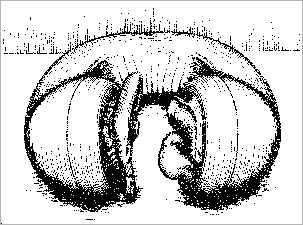 | FromMind Sights, by Shepard. |
"[A]n object that is novel and yet similar to an already significant object may ... warrant[s] our close attention. We need to know how far something can depart from its usual or expected form and still have the consequences that we have found to follow from its 'natural kind.' In doing so, we also come closer to an understanding of the critical features of a stimulus that elicits a resonant response within us and, thus, closer to an understanding of ourselves."
www.psychspace.com心理学空间网
